Waller declares "DeFi is no longer being ridiculed"—the US officially embraces stablecoins and tokenization, and a power reshuffle in traditional finance is underway
The Federal Reserve held its first payment innovation conference, discussing stablecoins, tokenization, and AI payments. The concept of a streamlined master account was proposed, and the legitimacy of the crypto industry was acknowledged, promoting the integration of traditional finance with digital assets. Summary generated by Mars AI.
Washington, D.C., October 21. The conference room at the Federal Reserve headquarters was packed with people who, just a few years ago, were seen as troublemakers in the financial system.
The founder of Chainlink, the president of Circle, the CFO of Coinbase, and the COO of BlackRock sat face-to-face with Federal Reserve Governor Christopher Waller, discussing stablecoins, tokenization, and AI payments.
This was the Federal Reserve's first-ever Payments Innovation Conference. The meeting was closed to the public but livestreamed in its entirety. The agenda listed four topics: the integration of traditional finance and digital assets, stablecoin business models, AI applications in payments, and tokenized products. Behind each topic lies a multi-trillion-dollar market.
Waller said in his opening remarks, "This is a new era for the Federal Reserve in the payments sector. The DeFi industry is no longer viewed with suspicion or ridicule." After this statement spread through the crypto community, bitcoin rose by 2% that day. In his opening speech, Waller also said, "Payment innovation is developing rapidly, and the Federal Reserve needs to keep up."
The Payments Innovation Conference featured four roundtable discussions. Beating summarized the content, and the following are the core topics and content of the conference:
The Federal Reserve's "Slimmed-Down Master Account"
The most important concept Waller proposed was something called the "streamlined master account."
The Federal Reserve's master account is the pass for banks to access the Fed's payment system. With this account, banks can directly use payment rails like Fedwire and FedNow, without intermediaries. But the threshold for a master account is high, and the approval process is lengthy; many crypto companies have applied for years without success.
Custodia Bank is a typical case. This Wyoming-based crypto bank began applying for a master account in 2020, was delayed by the Fed for over two years, and eventually sued the Federal Reserve. Kraken has faced similar issues.
Waller said that many payment companies do not need all the functions of a master account. They don't need to borrow from the Fed or have intraday overdrafts; they just need access to the payment system. So the Fed is studying a "streamlined" version to provide these companies with basic payment services while controlling risk.
Specifically, this account pays no interest, may have a balance cap, cannot be overdrawn or used for borrowing, but its approval process will be much faster.
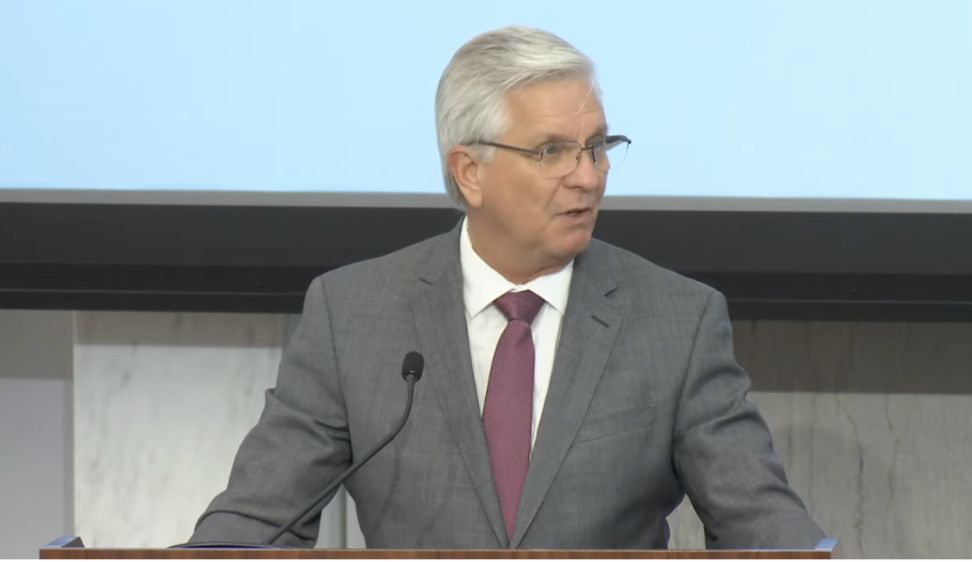
Federal Reserve Governor Waller
This proposal by Governor Waller means that stablecoin issuers and crypto payment companies could directly access the Fed's payment system, no longer relying on traditional banks.
This would significantly reduce costs and improve efficiency. More importantly, it marks the first time the Fed has formally recognized these companies as legitimate financial institutions.
Dialogue One: Traditional Finance Meets Digital Ecosystem
The first panel discussion focused on "the integration of traditional finance and the digital asset ecosystem." The moderator was Rebecca Rettig, Chief Legal Officer of Jito Labs. On stage were Sergey Nazarov, co-founder of Chainlink; Jackie Reses, CEO of Lead Bank; Michael Shaulov, CEO of Fireblocks; and Jennifer Barker, Global Head of Treasury Services and Depositary Receipts at BNY Mellon.
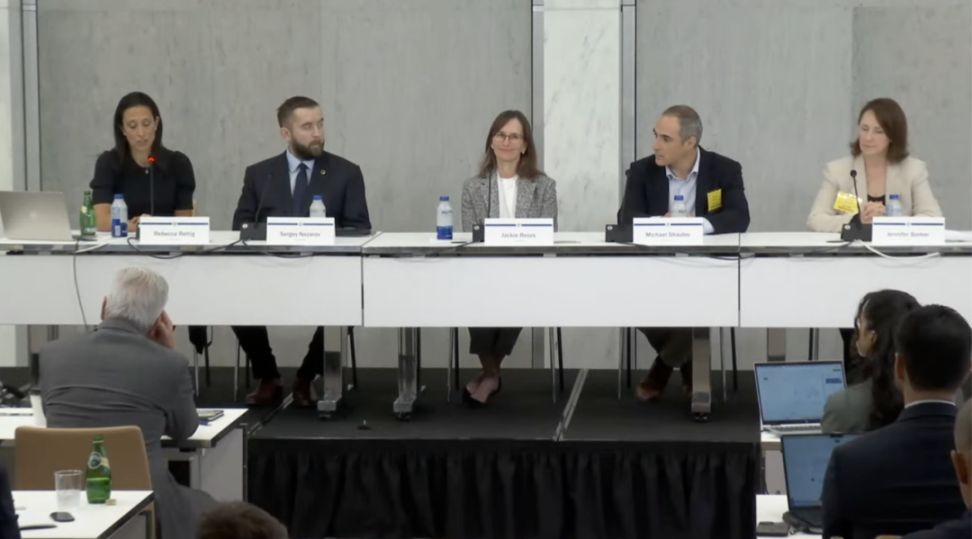
From left to right: Rebecca Rettig, Chief Legal Officer of Jito Labs; Sergey Nazarov, co-founder of Chainlink; Jackie Reses, CEO of Lead Bank; Michael Shaulov, CEO of Fireblocks; Jennifer Barker, Global Head of Treasury Services and Depositary Receipts at BNY Mellon
Interoperability is the Biggest Barrier to Integration
Chainlink co-founder Nazarov got straight to the point, saying the biggest issue now is interoperability. There is a lack of unified compliance standards, identity verification mechanisms, and accounting frameworks between blockchain assets and traditional financial systems. As the cost of creating new chains drops, the "fragmentation" of chains is intensifying, making the need for unified standards more urgent.
He called on the Fed to ensure that payment systems can interoperate with stablecoins and tokenized deposits. He stated that the payments sector represents the "buy side" of the digital asset economy, and if the Fed can provide a clear risk management framework, the U.S. can maintain its lead in global digital payment innovation.
He noted that a year ago, it was unimaginable to discuss "regulated DeFi" at the Fed, which itself marks a positive trend. Nazarov predicted that in the next 2 to 5 years, a hybrid model will emerge: a "Regulated DeFi Variant," where compliance processes are automated via smart contracts.
Traditional Banks Are Not Ready; The Core Bottleneck Is Cognition and Talent
Lead Bank CEO Reses believes that even with a blueprint for integrating traditional finance and the digital ecosystem, most banks are not ready to handle such integration. Traditional banks lack wallet infrastructure, systems for crypto on/off ramps, and, more importantly, "talent who understand blockchain products" internally.
She further summarized the issue as a gap in cognition and capability, emphasizing that the biggest obstacle is not the technology itself, but "the knowledge and execution ability of the core banking services team." These core teams, lacking the ability to understand and judge emerging blockchain products, simply do not know how to effectively regulate or supervise these new businesses.
This lack of readiness is especially evident on the retail side. Reses mentioned that while KYC systems for institutions are now quite mature, retail users still have difficulty accessing these tools. This exposes an awkward reality: even if banks want to participate, their service capabilities are limited to a few institutional clients, and mass adoption is still far off.
The Industry Needs Pragmatic Regulation and Risk Control Frameworks
This discussion also touched on the issue of AI fraud, leading to a debate on the "reversibility" of on-chain transactions. Traditional wire transfers can be reversed, but blockchain transactions are final. How to meet regulatory requirements for reversible processes while maintaining on-chain finality is a serious challenge. Reses called on regulators to proceed "slowly and steadily," because "innovation is always great—until your own family gets scammed."
Fireblocks CEO Michael Shaulov took the discussion deeper into economic and regulatory issues. He pointed out that stablecoins could reshape the credit market and thus affect the Fed's monetary policy. He also highlighted a specific regulatory gray area: when banks place "tokenized deposits" on public blockchains, the banks' responsibilities are unclear, which is a key issue hindering bank projects. He called for further research into how digital assets change banks' balance sheets and the Fed's role in this.
Finally, Jennifer Barker from BNY Mellon provided a "wish list" of four priorities that traditional banks hope regulators will address: enabling 24/7 payment systems, setting technical standards, enhancing fraud detection, and establishing liquidity and redemption frameworks for stablecoins and tokenized deposits.
Dialogue Two: The Troubles and Opportunities of Stablecoins
The second panel focused on stablecoins. The moderator was Kyle Samani, co-founder of Multicoin Capital. On stage were Charles Cascarilla, CEO of Paxos; Heath Tarbert, Chairman of Circle; Tim Spence, CEO of Fifth Third Bank; and Fernando Tres, CEO of DolarApp.

From left to right: Kyle Samani, co-founder of Multicoin Capital; Charles Cascarilla, CEO of Paxos; Tim Spence, CEO of Fifth Third Bank; Fernando Tres, CEO of DolarApp; Heath Tarbert, Chairman of Circle
Strong Demand and Use Cases for Compliant Stablecoins
In July this year, the U.S. passed the GENIUS Act, requiring stablecoin issuers to hold 100% high-quality reserve assets, mainly cash and short-term U.S. Treasuries.
After the act took effect, the share of compliant stablecoins rose from less than 50% at the start of the year to 72%. Circle and Paxos were the biggest beneficiaries. USDC's circulation reached $65 billion in Q2 this year, accounting for 28% of the global market, with annual growth exceeding 40%.
In terms of use cases, Spence, representing banks, offered the most pragmatic view. He believes the strongest and most direct use case for stablecoins is "cross-border payments," as they genuinely solve the pain points of traditional settlement delays and FX risk. In contrast, programmability for AI agent commerce is a more distant future.
Tres from DolarApp added a Latin American perspective, noting that for countries with unstable local currencies, stablecoins are not speculative tools but essential means of preserving value. He reminded the U.S.-centric decision-makers present that stablecoin use cases are far broader than they might imagine.
The "Dial-Up Internet" Experience Bottleneck
Cascarilla pointed out the industry's biggest growing pain: user experience.
He compared today's DeFi and crypto to the early days of "dial-up internet," bluntly stating that DeFi and crypto have not yet been sufficiently abstracted.
He believes that only when blockchain technology is well abstracted and becomes "invisible" will mass adoption occur. "No one knows how a mobile phone works... but everyone knows how to use it. Crypto, blockchain, and stablecoins need to be like that."
Cascarilla praised companies like PayPal, saying their integration of stablecoins into traditional finance is an early sign of this usability shift.
The Threat to the Banking Credit System
Circle's Tarbert and Fifth Third Bank's Spence also joined the discussion, representing the traditional banking perspective, which in itself is a signal.
Spence first tried to rebrand banks, suggesting "ScaledFi" (scaled finance) instead of "TradFi" (traditional finance), and said the "old" identity of banks "is the least interesting thing."
He also pointed out that stablecoins won't drain banks' "capital," but will drain "deposits." The real threat is that if stablecoins are allowed to pay interest (even disguised as "rewards" like Coinbase's USDC subsidies), it would pose a major threat to the formation of bank credit.
The core function of banks is to take deposits and make loans (i.e., credit creation). If stablecoins, with their flexibility and potential interest, siphon off large amounts of deposits, banks' lending capacity will shrink, threatening the entire economy's credit system. This is similar to the early impact of money market mutual funds (MMMFs) on the banking system.
Dialogue Three: AI Fantasies and Realities
The third panel focused on AI. The moderator was Matt Marcus, CEO of Modern Treasury. On stage were Cathie Wood, CEO of ARK Invest; Alesia Haas, CFO of Coinbase; Emily Sands, Head of AI at Stripe; and Richard Widmann, Web3 Strategy Lead at Google Cloud.
AI Is Ushering in the Era of "Agent Commerce"
Cathie Wood predicted that AI-driven "agent payment systems," where AI shifts from "knowing" to "doing" and can autonomously make financial decisions for users (such as paying bills, shopping, investing), will unleash tremendous productivity. She asserted, "We believe that with such breakthroughs and productivity gains, real GDP growth could accelerate to 7% or higher in the next five years."
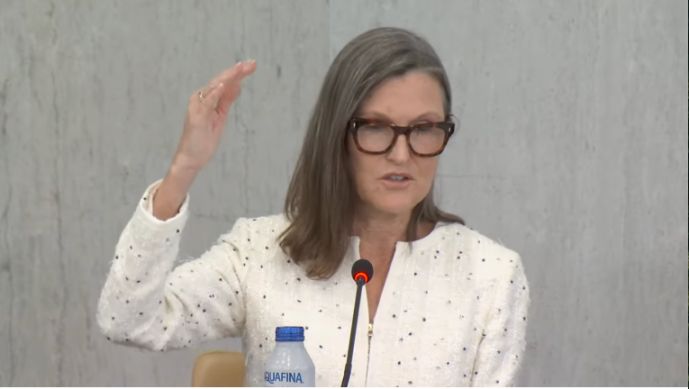
ARK Invest CEO Cathie Wood
Additionally, Wood named AI and blockchain as the two most important platforms driving this wave of productivity. Reflecting on U.S. regulation, she argued that early hostility toward blockchain was a blessing in disguise, forcing policymakers to rethink and sounding the alarm for the U.S. to reclaim leadership in the "next-generation internet."
Emily Sands from Stripe emphasized from a practical perspective that while AI agent shopping (such as one-click checkout via ChatGPT) is already emerging, mitigating fraud risk remains "one of the most urgent challenges." Merchants must clearly define how their systems interact with these AI agents to prevent new types of fraud.
In terms of improving financial efficiency, AI's impact is also remarkable. Alesia Haas from Coinbase said that by the end of the year, half of Coinbase's code will be written by AI bots, nearly doubling R&D productivity. For financial reconciliation, reconciling crypto transactions can be done by one person in half a day, while the same volume of fiat transactions requires 15 people and three days, showing how AI and crypto technology greatly reduce operational costs.
Stablecoins Are the New Financial Infrastructure Needed by AI Agents
The second consensus in the discussion was that AI agents need a new, native financial tool, and stablecoins are the natural solution.
Richard Widmann from Google Cloud explained that AI agents cannot open traditional bank accounts like humans, but they can have crypto wallets. Stablecoins provide the perfect solution, offering programmability and being especially suited for AI-driven automated microtransactions (such as two-cent payments) and machine-to-machine (M2M) settlements.
Alesia Haas from Coinbase added that the programmability of stablecoins and the increasingly clear regulatory environment make them the ideal choice for AI-driven transactions. The rapid monetization of AI companies (ARR growth is 3-4 times that of SaaS companies) also requires payment infrastructure to integrate new payment methods like stablecoins.
At the same time, stablecoins and blockchain technology provide new anti-fraud tools, such as using on-chain transaction visibility to train AI fraud models, address whitelisting/blacklisting mechanisms, and transaction finality (merchants face no chargeback risk).
Dialogue Four: Everything On-Chain
The fourth panel focused on tokenized products. The moderator was Colleen Sullivan, Head of Venture at Brevan Howard Digital. On stage were Jenny Johnson, CEO of Franklin Templeton; Don Wilson, CEO of DRW; Rob Goldstein, COO of BlackRock; and Carla Kennedy, Co-Head of Kinexys at JPMorgan.
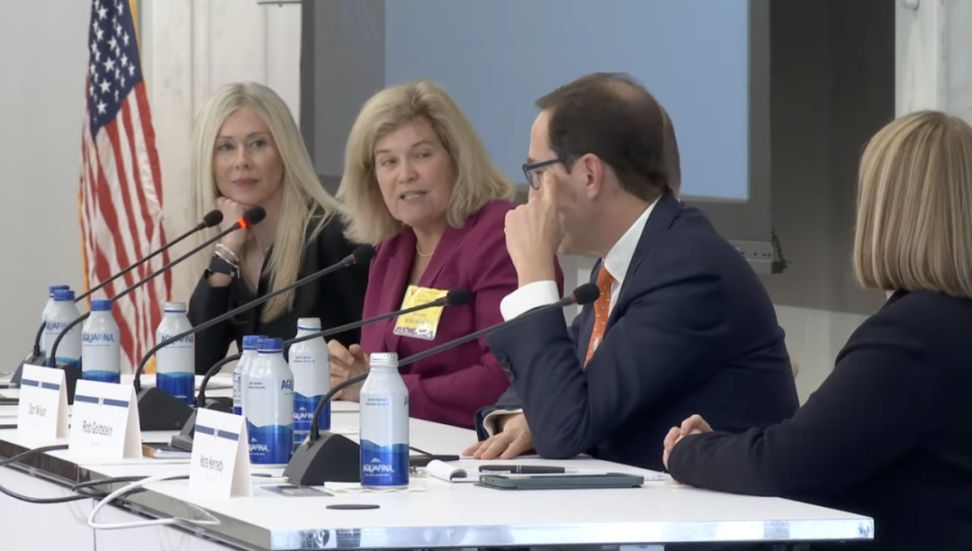
From left to right: Colleen Sullivan of BHD, Jenny Johnson, CEO of Franklin Templeton, Rob Goldstein, COO of BlackRock, Carla Kennedy, Co-Head of Kinexys at JPMorgan
On-Chain Traditional Financial Assets Are Only a Matter of Time
Participants unanimously agreed that asset tokenization is an irreversible trend. BlackRock COO Goldstein made the most direct statement: "It's not a question of if, but when." He noted that digital wallets already hold about $4.5 trillion, and as investors can directly hold tokenized stocks, bonds, and funds via blockchain portfolios, this number will continue to rise.
DRW's Wilson was even more specific, predicting that within five years, every frequently traded financial instrument will be traded on-chain. Johnson from Franklin Templeton compared this to historical technological revolutions, summarizing, "Technology adoption is always slower than people expect—then it suddenly takes off."
Tokenization is not a distant vision but an ongoing practice. Currently, traditional finance and digital assets are merging in both directions: traditional assets (such as stocks and Treasuries) are being tokenized and used in DeFi, while digital assets (such as stablecoins and tokenized money market funds) are being integrated into traditional markets.
Institutions have long been actively deploying. Johnson revealed that Franklin Templeton has launched a native on-chain money market fund (MMF) that enables second-by-second intraday yield calculation. Kennedy introduced JPMorgan Kinexys's progress, including using tokenized U.S. Treasuries for minute-level overnight repo transactions and launching a proof-of-concept for JPMD deposit tokens. Wilson confirmed that DRW is participating in on-chain U.S. Treasury repo transactions.
Never Replicate Crypto-Native "Bad Practices"
Despite the promising outlook, traditional financial giants remain highly vigilant about risks. They emphasized that tokenized assets, stablecoins, and deposit tokens should not be interchangeable, and the market must assess different assets' collateral "haircuts" based on credit quality, liquidity, and transparency.
BlackRock's Goldstein warned that many so-called "tokens" are actually complex "structured products" in disguise, and not fully understanding these structures is dangerous.
DRW's Wilson sharply pointed out the serious issues exposed by the recent crypto market flash crash (October 11): unreliable oracles and trading platforms conducting internal liquidations and suspending user deposits for profit, creating conflicts of interest.
He firmly stated that these are "bad practices" that traditional finance must not replicate before entering DeFi. Strict infrastructure oversight and market quality standards must be established first. Additionally, for compliance (AML/KYC) reasons, regulated banks must use permissioned distributed ledgers (Permissioned DLT).
Racing Ahead in Digital Finance: Who Is Winning?
The signal from this conference is clear: the Fed no longer sees the crypto industry as a threat, but as a partner.
In the past year or two, global competition in digital currencies has intensified. The digital yuan has made rapid progress in cross-border payments, with transaction volume reaching $870 billion in 2024. The EU's MiCA regulation has taken effect, and Singapore and Hong Kong are improving their crypto regulatory frameworks. The U.S. feels the pressure.
But U.S. policy is different. It does not promote a government-led central bank digital currency but embraces private sector innovation. The "Anti-CBDC Surveillance State Act" passed this year explicitly prohibits the Fed from issuing a digital dollar. The U.S. logic is to let companies like Circle and Coinbase handle stablecoins, let BlackRock and JPMorgan handle tokenization, and have the government only set rules and regulate.
The most direct beneficiaries are compliant stablecoin issuers. Circle and Paxos have seen their valuations surge in recent months. Traditional financial institutions are also accelerating their deployment; JPMorgan's JPM Coin has processed over $300 billion in transactions. Citi and Wells Fargo are testing digital asset custody platforms.
Data shows that 46% of U.S. banks now offer crypto-related services to clients, up from just 18% three years ago. The market response is also clear. Since the Fed signaled regulatory easing in April, the stablecoin market has grown from just over $200 billion at the start of the year to $307 billion.
There are deep political and economic considerations behind this strategy. A central bank digital currency would mean direct government surveillance of every transaction, which is hard to accept in U.S. political culture. In contrast, privately-issued stablecoins can maintain the dollar's global status while avoiding controversy over excessive government power.
But this strategy also carries risks. Private stablecoin issuers could form new monopolies, and their collapse could trigger systemic risk. How to balance encouraging innovation and preventing risk is the challenge facing U.S. regulators.
In his closing remarks, Waller said that consumers do not need to understand these technologies, but ensuring their safety and efficiency is everyone's responsibility. This may sound like official rhetoric, but the message is clear: the Fed has decided to bring the crypto industry into the mainstream financial system.
This conference did not release any policy documents or make any decisions. But the signal it sent is stronger than any official document. An era of dialogue has begun, and the era of confrontation is over.
Disclaimer: The content of this article solely reflects the author's opinion and does not represent the platform in any capacity. This article is not intended to serve as a reference for making investment decisions.
You may also like
Rate Hike in Japan: Will Bitcoin Resist Better Than Expected?
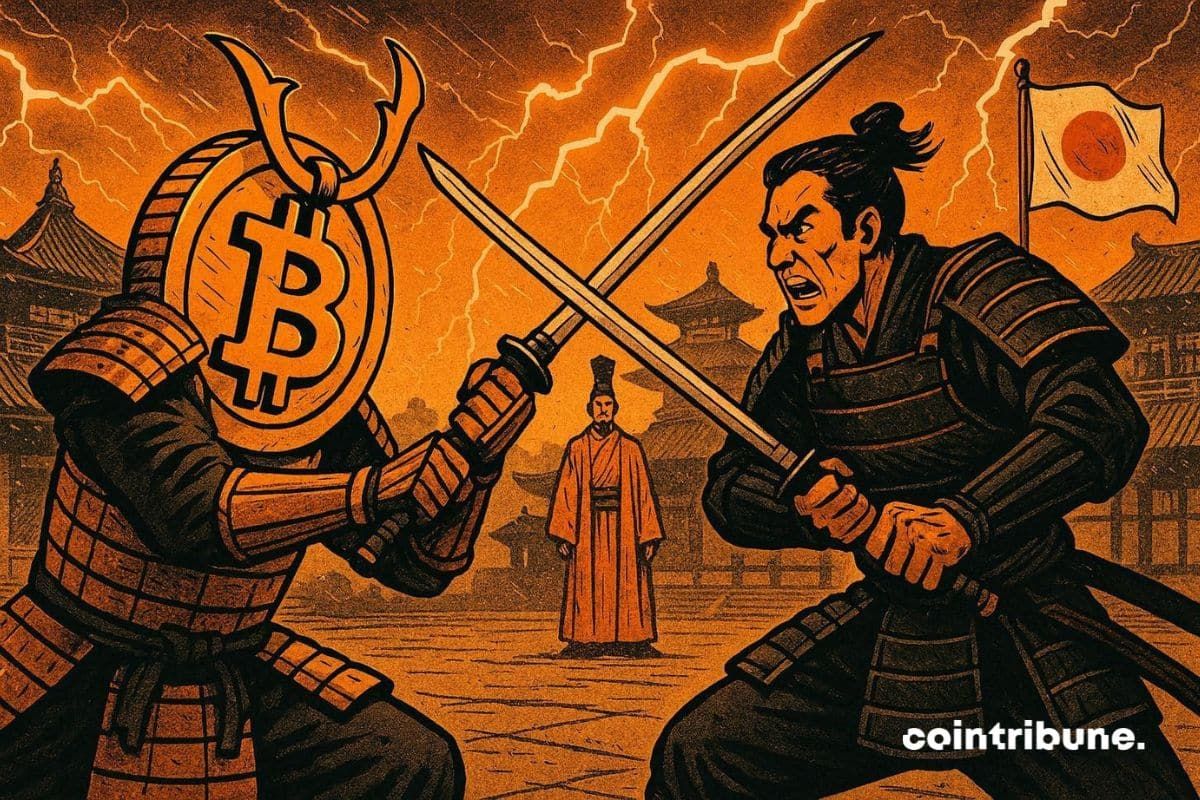
Crucial Decision: Trump’s Final Interviews for Federal Reserve Chair Could Reshape Markets
Spot Bitcoin ETFs Defy Odds with $150M Net Inflow Despite BlackRock’s $136M Outflow
Spot ETH ETFs Achieve Remarkable Second Day of Net Inflows as Confidence Soars
